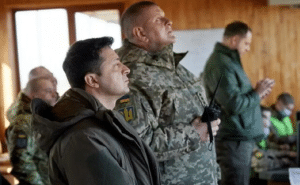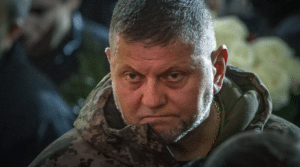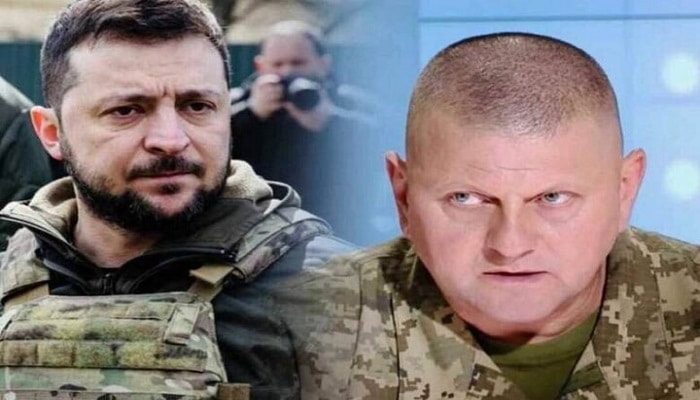PNN – While the US and British plan to remove Zelensky and replace him with Zaluzhny has become more prominent, the question arises: is the possible replacement a harbinger of peace or a prelude to a more aggressive phase?
In recent days, there have been serious signs of a tactical shift in the West’s strategy toward the war in Ukraine; a shift that has been reflected most of all in the desired leadership model for Ukraine’s future.
While Volodymyr Zelensky still remains president, numerous news and reports from Western, Russian, and even moderate media sources indicate that the United States and Britain are unofficially seeking to gradually replace Zelensky with Valery Zaluzhny, a popular and experienced general in the Ukrainian army.
These movements are taking place at a time when the stalemate on the battlefield, the erosion of public opinion, and the rise of internal divisions in Kiev have called into question Zelensky’s political legitimacy and opened the West’s hand to engineer the future of power in Ukraine.
Read more:
Unrest and restoration of anti-corruption institutions in Ukraine’
Simultaneously with these behind-the-scenes political movements, military tensions between NATO and Russia have also entered a new phase, including the deployment of American nuclear submarines to Northern European waters, joint British and Polish military exercises near the Belarusian borders, and direct threats from the Kremlin regarding the possibility of expanding the circle of war.
Zaluzhny vs. Zelensky: Two Faces, Two Paths
It is impossible to understand why Zaluzhny has become so prominent without comparing him to Zelensky. The two figures represent two completely different perspectives on Ukraine’s crisis management: one a military-minded, structuralist commander, the other a civic president with media and narrative skills.

Zelensky, an actor and comedian who won the 2019 presidential election on anti-corruption and grassroots rhetoric, became a symbol of national resistance at the start of the war with Russia. His power came not from his military structure but from his control of the media, his ability to mobilize public opinion, and his symbolic display of leadership in times of crisis. Zelensky, especially in 2022 and 2023, provided Ukraine with unprecedented global support through numerous trips to Western capitals and a knack for political branding.
But this intense focus on imagery turned into a weakness over time. Especially after the halt in advances on the fronts and the failure of Ukrainian counteroffensives in the summer of 2023, Ukrainian public opinion turned from political slogans to demands for concrete results, and the gap between Zelensky and military commanders, especially Zaluzhny, became more visible.
In contrast, General Valery Zaluzhny not only lacks political or party background, but has always tried to stay out of power struggles. He is a technocratic commander with an organizational mindset who has pushed the Ukrainian army towards a NATO-like structure: a combination of field agility, technology-centricity, delegation of responsibility to local commanders, and a focus on intelligence-operational coordination.
Unlike Zelensky, who rose to power through popularity, Zaluzhny rose through the ranks of the military and his popularity was built on his efficiency and seriousness on the battlefield. In some polls, Zaluzhny’s public trust has even surpassed Zelensky’s at over 70 percent.
Another difference is in how the future of the war is being faced. Zelensky continues to insist in his official discourse on final victory, the recovery of all lost territories, and the absence of negotiations with Putin. While Zaluzheni has referred to the limitations of military power, the lack of sufficient human resources, and the stalemate of the war in his speeches, and has indirectly raised the need for a strategic review, he has never explicitly called for negotiations, but has emphasized that victory is not possible through military means alone.
As a result, these two figures, one a media-oriented and political figure and the other a leader of the field and structure, each represent a different path in the future of Ukraine; Zelensky is assessed as continuing the media and political resistance relying on foreign support, and Zaluzhny as ending the war through the path of military rationality or initiating a more intense phase of conflict to change the balance.
There is no doubt that the West is now evaluating these two paths, and the prominence of Zaluzhenie is a more serious sign of a desire to rearrange the rules of the game.
Zaluzhenie: Prelude to Negotiation or Commander of the Final Battle?
General Valery Zaluzheny’s bold return to the media and political analysis scene has occupied the minds of many observers. Two major perceptions have emerged regarding this development, which, while contradictory, are both rooted in real data.

The first view sees Zaluzhny as a prelude to negotiations; a realistic, apolitical, and trusted figure in society who, unlike Zelensky, with his media-oriented and sometimes emotional approach, is capable of drawing a dignified end to the war. In this analysis, Zaluzhny is a commander who has been on the front lines of the war, understands the limitations of the military, and therefore has the legitimacy to make difficult decisions. In the West’s eyes, such a figure is the best option to move from the military to the political phase and enter into negotiations that must be conducted from a position of strength but also be acceptable to the Ukrainian people.
But against this view stands a counter-analysis that focuses on Zaluzhny’s military prowess and his aggressive record. From this perspective, the return of a general who modernized the backbone of the Ukrainian army and institutionalized NATO tactics into its structure is in no way compatible with the logic of retreat or compromise. He is a commander who, in a very difficult time, transformed a scattered and worn-out army into a disciplined, flexible and aggressive force. The re-use of Zaluzhny, especially after a decline in morale on the front lines, could be an attempt to restore military hope, change the field situation and prepare for the final phase of the conflict. In other words, if there is to be any negotiation, it must first pass through the barrel of cannon.
In summary, by highlighting Zaluzhny, the West is not following a single path, but is preparing itself for both possible paths. He is a strategic and versatile figure who, depending on the circumstances, can play the role of a general of reconciliation or a leader of the final battle.
The definitive answer to whether Zaluzhny is a signal for peace or a fire of war lies not in his background but in the decisions of Ukraine and its Western backers in the coming weeks and months. What is certain is that with Zaluzhny’s arrival, the Ukrainian case has entered a more sensitive, complex, and decisive phase—one that could redefine not only the future of Kiev but also the power balance between NATO, Russia, and Europe’s border states.

